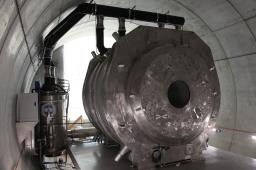The technique of magnetic resonance imaging (MRI) is a diagnostic tool for research and neuroscience. Its evolution led to instruments for whole body operating at very high field from 0.5 to 1.5 tesla for medical examinations and 3 to 5 tesla for research instruments.
Objectives
Neurospin project aims to develop a centre with 4 MRI systems:
o Clinic Research : MRI 3T and 7T (Siemens)
o Pre Clinic Research : MRI 17T, small aperture (Bruker)
o Clinic Research : MRI 11.75 T/900mm (ISEULT program)
o Pre Clinic Research : MRI 11.75T/1000mm (future project)
The last 2 MRI systems with high fields and large aperture do not exist on the market and are the subject of a R&D program with Siemens called Iseult.
In this context, the DAPNIA has been solicited for developing and manufacturing the superconducting magnets of 11.75T whole body.
Localization
CEA centre at Saclay.
Once built, the first magnet wil be integrated in the MRI system and installed in the Neurospin imaging centre at Saclay.
Technical Description
The main prototype investigations are described below and include:
A small superconducting coil to test the principles of homogenization from double pancake blocks.
A prototype of a small-scale for the study of components, manufacturing processes, electromagnetic operating conditions, thermal and thermo hydraulic envisaged for the magnet final.
A prototype (scale 1 OR actual size) produced from the assembly of 8 or 15 double pancake with the definitive design scale 1 in a cryostat for testing uniformity and stability of field.
At the same time, tests of these prototypes require the completion of specific cryogenic testing stations. The use of these stations will also provide an opportunity to assess and validate the developments made on cryogenics to 1.8 K, electrical power, command control and protection of the magnet.
Specific Features
The main specific features of this magnet lies in the following points:
Design and manufacture of a magnet producing a 11.75T field in a diameter of 900 mm with as main features :
- the Level Field (11.75 T) never yet obtained for a magnet whole body (internal diameter of 900 mm)
- the magnet dimensions : 4 m diameter and 4 m in length) and the weight (nearly 150 tons)
- the technology achievement winding through double pancake, similar to the one used on ToreSupra never used for MRI.
- The current used is greater than 1000 A which requires a large conductor with potential stability problems with some difficulties to achieve critical current densities
- the cryostability of the winding at 1.8 K
- the need for a vast number of connections to high current
- a spatial uniformity less than 10-7 on 10 cm
- a stability in time up to 10-10 per min, which will require to develop a technique for specific current supply
- the active shielding allowing a leakage field of about 5 gauss at 10 m lengthwise and 5 m radially
- the use of a pressurized 1.8 K bath and of a liquefactor permanently connected to the magnet
DAPNIA Contribution
Scientific and Technical Responsibilities
The Dapnia responsabilities are the following :
11,75 Tesla Magnet :
- Master builder for the magnet 11.75T (leader of the corresponding « sub-workpackage ».
- Review of the magnet.
- Study of industrial components and follow up of their manufacturing (conductor, coils, coil box, etc).
- Manufacturing of prototypes.
- Follow-up of the magnet assembly.
- Critical components tests.
- Tests and prototype validation.
- Test and receipt of the final magnet.
A test bench has to be done to validate components.
Design and manufacturing of the RF antenna (500MHz)
Contact
Project Manager : Pierre VÉDRINE





